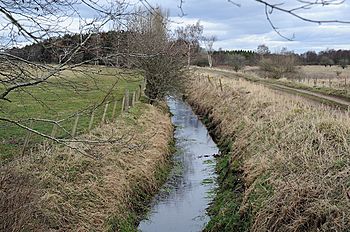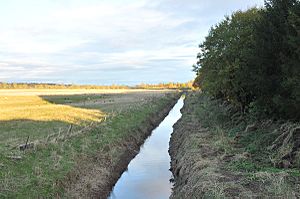Pow of Inchaffray facts for kids
Quick facts for kids Pow of Inchaffray |
|
|---|---|

Upper reaches of the Pow near Balgowan
|
|
|
Location of the mouth of the Pow within Scotland
|
|
| Other name(s) | Pow Water |
| Physical characteristics | |
| River mouth | River Earn 56°20′48″N 3°47′07″W / 56.3467°N 3.7852°W |
| Length | 9 miles (14 km) |
| Basin features | |
| Basin size | 2,047 acres (8.28 km2) |
| Population | 79 residential properties, 21 agricultural properties and 2 commercial properties |
The Pow of Inchaffray, also known as the Pow Water, is a special ditch in Strathearn, Scotland. It is about 9 miles (14.5 km) long. This ditch helps drain 3.2 square miles (8.3 km²) of rich farmland. The Pow is very old, going back to the Middle Ages. It was first dug by the religious leaders of the nearby Inchaffray Abbey. Later, it was made even bigger with permission from Robert the Bruce.
Since 1696, a special group called a drainage commission has been in charge of the Pow. This group was set up by the Parliament of Scotland. It is the only local drainage commission in Scotland. This commission still looks after the Pow and collects money from landowners who benefit from it. A new law was passed in 2018 to update how the commission works.
What is the Pow of Inchaffray?
The Pow starts at Methven Moss. It flows southwest for 9 miles (14.5 km). It then joins the River Earn near Innerpeffray, which is about 2.5 miles (4 km) southeast of Crieff. The area that the Pow drains is called its drainage basin. This basin covers 2,047 acres (8.28 km²). It includes 79 homes, 21 farms, and 2 businesses.
The Pow has ten main smaller streams that flow into it. These streams add up to about 4.7 miles (7.6 km) of waterways. People have different ideas about the Pow's main purpose. Some think it is for draining water from the ground. Others believe it is mainly to prevent floods.
A Look Back: The Pow's History
The word "Pow" comes from the Scots language. It dates back to the Early Middle Ages and means an artificial ditch. The Pow was first dug by the canons (religious leaders) of Augustinian Inchaffray Abbey. This abbey was one of the biggest in Scotland at the time. It was built on an island in a marshy area. The Pow was created to help drain the land around the abbey.
Abbot Maurice of Inchaffray was a close advisor to Robert the Bruce. Before the 1314 Battle of Bannockburn, Maurice said he saw a miracle. A bone of Saint Fillan appeared in a special container that was empty before. Robert the Bruce believed this miracle helped him win the battle. To thank Maurice, he gave the abbey permission to make the Pow even longer. The abbey became less important after the Scottish Reformation and was slowly left empty. But the Pow continued to be used.
How the Pow is Managed Today
In 1696, the Pow was officially put under the care of a drainage commission. This was done by a law from the Parliament of Scotland. The law was called "Act in favour of Sir Robert Murray of Abercairney and other heritors upon the Pow of Inchaffray." This commission was given the power to collect taxes from "heritors." Heritors were landowners who benefited from the Pow. The money was used to keep the ditch working and make it better. The law noted that "the grass and corns of several heritors of the said lands are frequently lost and rendered useless" because of too much water.
This 1696 law was later replaced by a new law in 1846. This new law, called the "Pow of Inchaffray Drainage Act 1846," was passed by the Parliament of the United Kingdom. It also included plans for building new flood defenses.
In 2017, the drainage commissioners proposed a new law to the Scottish Parliament. This new law would make the commission a "body corporate." This means it would be recognized as a single legal entity. It would also help the commission deal with changes in the size of the drainage basin and the number of landowners. This new law was approved and became the "Pow of Inchaffray Drainage Commission (Scotland) Act 2019" on January 17, 2019.
The Pow drainage commission is the only local drainage commission in Scotland. It helps manage some of the country's most fertile farmland. It has also helped allow new homes to be built in parts of the drainage basin. The Pow is home to beavers that are not native to the area. The commissioners have been talking with Scottish Natural Heritage about trying out special fences and water-gates to manage the beavers.



